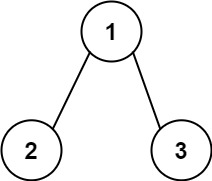英文原文
Given the root of a binary tree and an integer targetSum, return true if the tree has a root-to-leaf path such that adding up all the values along the path equals targetSum.
A leaf is a node with no children.
Example 1:

Input: root = [5,4,8,11,null,13,4,7,2,null,null,null,1], targetSum = 22 Output: true Explanation: The root-to-leaf path with the target sum is shown.
Example 2:

Input: root = [1,2,3], targetSum = 5 Output: false Explanation: There two root-to-leaf paths in the tree: (1 --> 2): The sum is 3. (1 --> 3): The sum is 4. There is no root-to-leaf path with sum = 5.
Example 3:
Input: root = [], targetSum = 0 Output: false Explanation: Since the tree is empty, there are no root-to-leaf paths.
Constraints:
- The number of nodes in the tree is in the range
[0, 5000]. -1000 <= Node.val <= 1000-1000 <= targetSum <= 1000
中文题目
给你二叉树的根节点 root 和一个表示目标和的整数 targetSum ,判断该树中是否存在 根节点到叶子节点 的路径,这条路径上所有节点值相加等于目标和 targetSum 。
叶子节点 是指没有子节点的节点。
示例 1:

输入:root = [5,4,8,11,null,13,4,7,2,null,null,null,1], targetSum = 22 输出:true
示例 2:

输入:root = [1,2,3], targetSum = 5 输出:false
示例 3:
输入:root = [1,2], targetSum = 0 输出:false
提示:
- 树中节点的数目在范围
[0, 5000]内 -1000 <= Node.val <= 1000-1000 <= targetSum <= 1000
通过代码
高赞题解
这个题要背下来!!
DFS
首先是 DFS 解法,该解法的想法是一直向下找到叶子节点,如果到叶子节点时sum == 0,说明找到了一条符合要求的路径。
我自己第一遍做的时候犯了一个错误,把递归函数写成了下面的解法:
def hasPathSum(self, root: TreeNode, sum: int) -> bool:
if not root:
return sum == 0
return self.hasPathSum(root.left, sum - root.val) or self.hasPathSum(root.right, sum - root.val)这种代码的错误在,没有判断 root 是否为叶子节点。比如 root 为空的话,题目的意思是要返回 False 的,而上面的代码会返回 sum == 0。又比如,对于测试用例 树为[1,2], sum = 0 时,上面的结果也会返回为 True,因为对于上述代码,只要左右任意一个孩子的为空时 sum == 0 就返回 True 。
当题目中提到了叶子节点时,正确的做法一定要同时判断节点的左右子树同时为空才是叶子节点。
Python 代码如下:
[]# Definition for a binary tree node. # class TreeNode(object): # def __init__(self, x): # self.val = x # self.left = None # self.right = None class Solution(object): def hasPathSum(self, root, sum): """ :type root: TreeNode :type sum: int :rtype: bool """ if not root: return False if not root.left and not root.right: return sum == root.val return self.hasPathSum(root.left, sum - root.val) or self.hasPathSum(root.right, sum - root.val)
[]/** * Definition for a binary tree node. * public class TreeNode { * int val; * TreeNode left; * TreeNode right; * TreeNode(int x) { val = x; } * } */ public class Solution { public boolean hasPathSum(TreeNode root, int sum) { if(root == null){ return false; } if(root.left == null && root.right == null){ return root.val == sum; } return hasPathSum(root.left, sum - root.val) || hasPathSum(root.right, sum - root.val); } }
回溯
这里的回溯指 利用 DFS 找出从根节点到叶子节点的所有路径,只要有任意一条路径的 和 等于 sum,就返回 True。
下面的代码并非是严格意义上的回溯法,因为没有重复利用 path 变量。
Python 代码如下:
[]# Definition for a binary tree node. # class TreeNode(object): # def __init__(self, x): # self.val = x # self.left = None # self.right = None class Solution(object): def hasPathSum(self, root, sum): """ :type root: TreeNode :type sum: int :rtype: bool """ if not root: return False res = [] return self.dfs(root, sum, res, [root.val]) def dfs(self, root, target, res, path): if not root: return False if sum(path) == target and not root.left and not root.right: return True left_flag, right_flag = False, False if root.left: left_flag = self.dfs(root.left, target, res, path + [root.left.val]) if root.right: right_flag = self.dfs(root.right, target, res, path + [root.right.val]) return left_flag or right_flag
BFS
BFS 使用 队列 保存遍历到每个节点时的路径和,如果该节点恰好是叶子节点,并且 路径和 正好等于 sum,说明找到了解。
Python 代码如下:
[]# Definition for a binary tree node. # class TreeNode: # def __init__(self, x): # self.val = x # self.left = None # self.right = None class Solution: def hasPathSum(self, root: TreeNode, sum: int) -> bool: if not root: return False que = collections.deque() que.append((root, root.val)) while que: node, path = que.popleft() if not node.left and not node.right and path == sum: return True if node.left: que.append((node.left, path + node.left.val)) if node.right: que.append((node.right, path + node.right.val)) return False
栈
除了上面的 队列 解法以外,也可以使用 栈,同时保存节点和到这个节点的路径和。但是这个解法已经不是 BFS。因为会优先访问 后进来 的节点,导致会把根节点的右子树访问结束之后,才访问左子树。
可能会有朋友好奇很少见到这种写法,为什么代码可行?答案是:栈中同时保存了 (节点,路径和),也就是说只要能把所有的节点访问一遍,那么就一定能找到正确的结果。无论是用 队列 还是 栈,都是一种 树的遍历 方式,只不过访问顺序有所有不同罢了。
Python 代码如下:
[]# Definition for a binary tree node. # class TreeNode(object): # def __init__(self, x): # self.val = x # self.left = None # self.right = None class Solution(object): def hasPathSum(self, root, sum): """ :type root: TreeNode :type sum: int :rtype: bool """ if not root: return False stack = [] stack.append((root, root.val)) while stack: node, path = stack.pop() if not node.left and not node.right and path == sum: return True if node.left: stack.append((node.left, path + node.left.val)) if node.right: stack.append((node.right, path + node.right.val)) return False
统计信息
| 通过次数 | 提交次数 | AC比率 |
|---|---|---|
| 294134 | 558725 | 52.6% |
提交历史
| 提交时间 | 提交结果 | 执行时间 | 内存消耗 | 语言 |
|---|
相似题目
| 题目 | 难度 |
|---|---|
| 路径总和 II | 中等 |
| 二叉树中的最大路径和 | 困难 |
| 求根节点到叶节点数字之和 | 中等 |
| 路径总和 III | 中等 |
| 路径总和 IV | 中等 |




